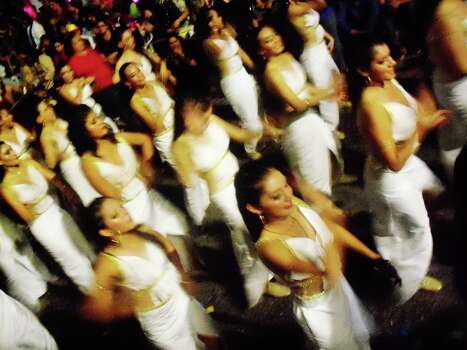chron.com
By Bob Cooper
January 30, 2014
Each night during Carnaval, a river of humanity flows onto Mazatlan's malecón.
The
world's longest uninterrupted promenade, curving beguilingly for four
miles on the Pacific, is taken over nightly by families and
dressed-to-kill singles for a week-long blur of parades, concerts,
beauty contests and fireworks. Shrimp is grilled and margaritas mixed on
street corners where mariachi bands brass up the mood. Music, food
smells and celebrants spill out of the restaurants, nightclubs, bars and
small hotels. The spectacle repeats itself for the 116th year on Feb.
27 to March 4.
Rio's Carnaval and New Orleans' Mardi Gras
are better known worldwide, but the world's third-largest such festival
in Mazatlan draws more than 600,000 people for the Sunday parade - the
largest event among many. Most are from Mexico, but many visitors also
arrive from the U.S., Canada and other Latin American countries. The
tradition, a "last hurrah" before Lent begins on Ash Wednesday,
commenced in Mazatlan in 1898. A heavy police presence ensures that the
potent mix of crowds, street music and Pacifico beer, which flows
nightly until 4 a.m., is remarkably peaceful.
"Put that many people in that small a space with all that alcohol in America, and you'd have problems," says Kurt Miller,
53, an Oregon truck stop owner who spends several weeks a year at his
winter home in Mazatlan with his wife, P.J. "But at Carnaval, everyone
gets along and has a good time." At his first one, he sat with Mexican
friends and their 60 extended family members - grandparents, uncles,
aunts, cousins. "It's a huge part of the culture."
Culture and
tradition share equal billing with food and beverage at the three-ring
circus that is Carnaval. The baseball stadium is transformed into a
sold-out concert venue, with nightly themed performances by the region's
opera, ballet, symphony and dance companies.
-On the night I attended, dance troupes accompanied by a full orchestra and chorus performed show tunes ("Mary Poppins"
songs are just as delightful in Spanish). Seniors and couples filled
the stadium seats, while los niños in centerfield folding chairs chomped
away on churros.
The beauty contest the next night on the malecón
is another crowd favorite. Most of the stiletto-and-gown-wearing
contestants vying for Queen of the Carnaval were teens from cities and
states around Mexico, but one arrived from Ecuador and two from Southern
California. By custom, most were dutifully escorted to the stage by
their mothers.
The ceremony was followed by a massive fireworks
and searchlight show, with flares fired from the beach and from boats
docked offshore above the C-shaped bay. Hip-hop, classical and Mexican
hits boomed from speakers all along the seawall, with the beat
coordinated to the explosions in the sky.
I expected families at
the children's dances the next day, but not at the bullfight. This
tradition, too, is revered by Carnaval-goers of all ages. It begins with
preliminary bouts-a flurry of pawing, snorting, charging and ultimately
collapsing bulls.
It wasn't all one-sided last winter, as one
picador was gored and limped off after brushing too close to a bull's
horns. Finally the crowd roared their approval when the horseback
headliner strutted out. Spaniard Pablo Hermoso is the Rafael Nadal
of rejoneo (bullfighting on Arabian horses), and he displayed the skill
of a champion athlete in his deadly dance with the bull, Gitano. After
much taunting, Gitano was soon vanquished, roses were tossed into the
ring and mules were summoned to haul off the body. Bullfights, I
learned, are an acquired taste.
It's the parades that have been
Carnaval's signature events ever since decorated bicycles and horse
carriages enlivened the malecón route in 1898. Now mounted on trucks,
the floats are creative and lavish, flashing with multicolored lights,
thumping with banda music (the region's odd blend of mariachi and German
polka) and jumping with costumed - and barely costumed - singers and
dancers. In one float, a chorus of beaming grandmothers sang, danced and
waved to the Sunday parade throng, which far exceeded the 440,000
population of Mazatlan. On the sidewalks, vendors sold light sticks and
toys to the kids, and masks, rainbow-striped Afro wigs and bead
necklaces to adults.
"We really enjoy watching the cultural shows, the crowning of the child queen and the fireworks," says Steve Backman,
53, a chiropractor from California who settled with his wife and three
daughters in Mazatlan seven years ago. One of 7,000 expatriates from the
U.S. and Canada who reside year-round in Mazatlan, he heads up Friends
of Mexico, which provides scholarships and school supplies to local
students. "Unlike New Orleans and Rio, Mazatlan celebrates Carnaval with
a family atmosphere," he says, "plus a lot of beer thrown in."
Once
the last of the floats, bands and dance troupes complete the parade
route, spectators wander back to their buses, cars and colorful pulmonia
cabs (picture the lovechild of a golf cart and a Manila Jeepney), or
to restaurants, bars and hotels to celebrate longer into the night. Most
return to the scene on Fat Tuesday, the traditional final night of
Carnaval, for one last parade, one final blowout of color, sound and
motion. Then it's back to normal until the same time, next year.
Bob Cooper is a freelance writer.


No comments:
Post a Comment